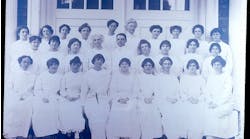The dental hygienist's role is critical in many areas of the general practice. In addition to providing excellent hygiene services, including scaling and root planing, periodontal therapy, and discussing the dental needs of the patient, the dental hygienist must also screen patients for oral cancer, occlusal problems, and temporomandibular joint problems.
As Dr. Peter Dawson explains in his textbook, Evaluation, Diagnosis, and Treatment of Occlusal Problems, people lose teeth for two major reasons - microorganisms and stress. The traditional approach of the hygienist is to evaluate the mouth for damage caused by microorganisms. Hygienists are experts at controlling bacterial plaque, which causes caries, gingival inflammation, and bone loss. Controlling stress in the masticatory system can be just as critical as controlling the microorganisms. The dental hygienist is in the perfect position to screen for "stress in the system" caused by occlusal and temporomandibular disorders.
The importance of temporomandibular joint
The TMJ is a complex joint that sits in front of the ear. It hinges, but also slides. The condyle or the ball, and the glenoid fossa or the socket, are separated by the intra-articular disc. This disc is a shock-absorbing piece of cartilage that is supposed to stay between the condyle and the fossa. When there is clicking and popping, it is frequently a sign that a part or the entire disc has been displaced or damaged.
It is critical that the doctor and hygienist are on the same page with TMJ and occlusal problems. The logical first step is for the doctor and the hygienist to attend continuing education courses on TMJ and occlusion, as well as devote staff meeting time to discuss TMJ and occlusion.
Screening for TMJ and occlusal pathology
The best way to screen for TMJ and occlusal problems is by asking a series of questions:
• Do you suffer from headaches? How often? In what area of your head?
• Have you ever experienced headaches near the temples upon awakening?
• Have you ever been aware of clicking or popping near your ears?
• Do you have clicking or popping now?
• Has your jaw ever locked open or closed even for a few seconds?
• Are you aware of grinding or clenching your teeth?
• Has your bite ever felt "off," where the teeth do not meet correctly?
• Have you ever had a traumatic injury to your jaw, neck, or head?
• Do you wear any type of dental appliances?
• Have you noticed any loose, shifting, moving, or worn-out teeth?
• Do you have jaw or ear pain?
Positive answers to even a few of these questions are a good indicator that there is a problem worth pursuing at a separate examination and consultation with the doctor. The responses should be noted in the patient's dental history. For each positive response, the hygienist should ask further questions to allow the patient to fully explain. For example, if the patient answers that they have experienced clicking or popping, the dental hygienist may comment, "Please tell me a little more about the clicking or popping." The patient can respond with details about how often, how noticeable, if it comes and goes, if it happened once and then never again, etc.
The TMD and occlusal screening examination protocol for the dental hygienist consists of an extraoral and intraoral exam.
• Extraoral evaluation
• Extraoral palpation of the TMJ. Ask the patient if they feel pain or discomfort during the palpation.
• Have the patient open and close while palpating. Ask if they feel pain or discomfort. As the patient opens, it is very easy to feel clicking and popping. You may feel your fingertips fall behind the condyle as the jaw opens. Ask the patient if they feel pain or discomfort in this area.
• Palpate the temporalis and masseter muscles on the sides of the jaws and above the ears, and ask if there is pain or discomfort.
• Observe the patient while they are opening and closing to see if there are any deviations or limitations.
• Is the patient's degree of opening limited in any way? Is it painful for them to stay open?
• Intraoral evaluation
• Do the teeth have wear? Is it generalized or in one specific area, such as the front teeth? Observe the canines. Are they worn? These are typically the first teeth to be worn out at the incisal edges. Are there any broken cusps or marginal ridges? Is the wear from bruxing or from some type of erosion, such as acid erosion in a bulimic patient? Careful observation of the surface of the teeth will reveal a lot of information.
• Are the teeth mobile? If they are, is there associated bone loss? Wear and occlusal forces cannot cause periodontal disease, but they can certainly worsen it!
• If the patient has crown and bridge dentistry in their mouth, is there a lot of broken and chipped porcelain?
• Are there abfractions and/or gum recession? Abfrac-tion lesions look like divots in the CEJ areas of the teeth. This can be associated with occlusal disease.
• Are there any teeth that have moved or tilted? These are signs of instability.
Dental hygienists are primary care providers who see individual patients two to six times a year. TMJ and occlusomuscular disorders are frequently overlooked in dentistry. Hygienists have the opportunity to discuss dental and medical histories and the patient's present medical condition. As part of this effort, the TMJ and occlusomuscular systems should be observed, evaluated, and discussed with every patient. Hygienists can use this clinical data to advise the doctor of the patient's condition and to begin a dialogue with the patient to raise their awareness of their TMJ and occlusal condition. Dental hygienists should also utilize their knowledge of temporomandibular disorders and occlusion to help in actual treatment and comfort consideration for their patients' hygiene visits.
Steven E. Roth, DMD, is a graduate of Columbia University and the University of Pennsylvania School of Dental Medicine. He is on the staff at Beth Israel Medical Center. Dr. Roth is also a graduate of the NYU Rosenthal Institute for Aesthetic Dentistry. Dr. Roth has lectured on cosmetic centistry, TMJ headaches and bruxism. He has appeared on Inside Edition, as well as NY1 and several other cable TV shows about cosmetic dentistry. He is a consultant to WebMD and is co-founder of FishmanRoth Associates.








